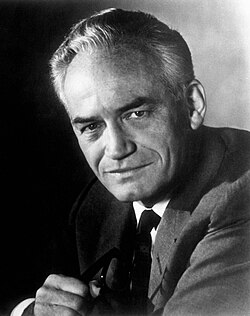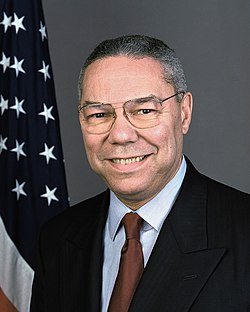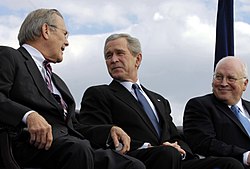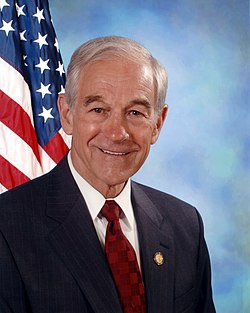21st century factions

During the presidency of Barack Obama, the Republican Party experienced internal conflict between its governing class (known as the Republican establishment) and the anti-establishment, small-government Tea Party movement. [4] [5] [6] [7] In 2019, during the presidency of Donald Trump, Perry Bacon Jr. of FiveThirtyEight.com asserted that there were five groups of Republicans: Trumpists, Pro-Trumpers, Trump-Skeptical Conservatives, Trump-Skeptical Moderates, and Anti-Trumpers. [8]
In February 2021, following Trump's 2020 loss to Democrat Joe Biden and the 2021 United States Capitol attack, Philip Bump of The Washington Post posited that the Republican Party in the U.S. House of Representatives consisted of three factions: the Trumpists (who voted against the second impeachment of Donald Trump in 2021, voted against stripping Marjorie Taylor Greene of her committee assignments, and supported efforts to overturn the results of the 2020 presidential election), the accountability caucus (who supported either the Trump impeachment, the effort to discipline Greene, or both), and the pro-democracy Republicans (who opposed the Trump impeachment and the effort to discipline Greene but also opposed efforts to overturn the 2020 presidential election results). [9] Also in February 2021, Carl Leubsdorf of the Dallas Morning News asserted that there were three groups of Republicans: Never Trumpers (including Bill Kristol, Sen. Mitt Romney, and governors Charlie Baker and Larry Hogan), Sometimes Trumpers (including Senate Minority Leader Mitch McConnell and former U.N. Ambassador Nikki Haley), and Always Trumpers (including Sens. Ted Cruz and Josh Hawley). [10]
In March 2021, one survey indicated that five factions of Republican voters had emerged following Trump's presidency: Never Trump, Post-Trump G.O.P. (voters who liked Trump but did not want him to run for president again), Trump Boosters (voters who approved of Trump, but identified more closely with the Republican Party than with Trump), Die-hard Trumpers, and Infowars G.O.P. (voters who subscribe to conspiracy theories). [11] In November 2021, Pew Research Center identified four Republican-aligned groups of Americans: Faith and Flag Conservatives, Committed Conservatives, the Populist Right, and the Ambivalent Right. [12]
As of 2023, congressional Republicans refer to the various House Republican factions as the Five Families. [13] [14] [15] [16] Derived from The Godfather , the term refers to Mafia crime families. [14] The Five Families consist of "the right-wing House Freedom Caucus, the conservative Republican Study Committee, the business-minded Main Street Caucus, the mainstream Republican Governance Group", and the Republican members of the bipartisan Problem Solvers Caucus. The House Republican factions overlap with one another, and some members belong to no caucus. [15]
Conservatives

The conservative wing grew out of the 1950s and 1960s, with its initial leaders being Senator Robert A. Taft, Russell Kirk, and William F. Buckley Jr. Its central tenets include the promotion of individual liberty and free-market economics and opposition to labor unions, high taxes, and government regulation. [17] The Republican Party has undergone a major decrease in the influence of its establishment conservative faction since the election of Donald Trump in 2016. [18] [19] [20]
In economic policy, conservatives call for a large reduction in government spending, less regulation of the economy, and privatization or changes to Social Security. Supporters of supply-side economics and fiscal conservatives predominate, but there are deficit hawks and protectionists within the party as well. Before 1930, the Northeastern industrialist faction of the GOP was strongly committed to high tariffs, a political stance that returned to popularity in many conservative circles during the Trump presidency. [21] [22] The conservative wing typically supports socially conservative positions, such as supporting gun rights and restrictions on abortion, though there is a wide range of views on such issues within the party. [23]

Conservatives generally oppose affirmative action, support increased military spending, and are opposed to gun control. On the issue of school vouchers, conservative Republicans split between supporters who believe that "big government education" is a failure and opponents who fear greater government control over private and church schools. Parts of the conservative wing have been criticized for being anti-environmentalist [25] [26] [27] and promoting climate change denial [28] [29] [30] in opposition to the general scientific consensus, making them unique even among other worldwide conservative parties. [30]
Long-term shifts in conservative thinking following the election of Trump have been described as a "new fusionism" of traditional conservative ideology and right-wing populist themes. [31] These have resulted in shifts towards greater support of national conservatism, [32] protectionism, [33] cultural conservatism, a more realist foreign policy, skepticism of neoconservatism, reduced efforts to roll back entitlement programs, and a disdain for traditional checks and balances. [31] [34]
Christian right

The Christian right is a conservative Christian political faction characterized by strong support of socially conservative and Christian nationalist policies. [35] [36] [37] Christian conservatives seek to use the teachings of Christianity to influence law and public policy. [38]
In the United States, the Christian right is an informal coalition formed around a core of evangelical Protestants and conservative Roman Catholics, as well as a large number of Latter-day Saints (Mormons). [39] [40] [41] [42] The movement has its roots in American politics going back as far as the 1940s and has been especially influential since the 1970s. [43] In the late 20th century, the Christian right became strongly connected to the Republican Party. [44] Republican politicians associated with the Christian right in the 21st century include Tennessee Senator Marsha Blackburn, former Arkansas Governor Mike Huckabee, and former Senator Rick Santorum. [45] Many within the Christian right have also identified as social conservatives, which sociologist Harry F. Dahms has described as Christian doctrinal conservatives (anti-abortion, anti-LGBT rights) and gun-rights conservatives (pro-NRA) as the two domains of ideology within social conservatism. [46] Christian nationalists generally seek to declare the U.S. a Christian nation, enforce Christian values, and overturn the separation of church and state. [36] [37]
Libertarians

Libertarians make up a relatively small faction of the Republican Party. [47] [48] In the 1950s and 60s, fusionism—the combination of traditionalist and social conservatism with political and economic right-libertarianism—was essential to the movement's growth. [49] This philosophy is most closely associated with Frank Meyer. [50] Barry Goldwater also had a substantial impact on the conservative-libertarian movement of the 1960s. [51]
Libertarian conservatives in the 21st century favor cutting taxes and regulations, repealing the Affordable Care Act, and protecting gun rights. [52] On social issues, they favor privacy, oppose the USA Patriot Act, and oppose the war on drugs. [52] On foreign policy, libertarian conservatives favor non-interventionism. [53] [54] The Republican Liberty Caucus, which describes itself as "the oldest continuously operating organization in the Liberty Republican movement with state charters nationwide", was founded in 1991. [55] The House Liberty Caucus is a congressional caucus formed by former Representative Justin Amash, a former Republican of Michigan who joined the Libertarian Party in 2020 before returning in 2024. [56]
Prominent libertarian conservatives within the Republican Party include New Hampshire Governor Chris Sununu, [57] [58] Senators Mike Lee and Rand Paul, Representative Thomas Massie, former Representative and Governor of South Carolina Mark Sanford, [59] and former Representative Ron Paul [60] (who was a Republican prior to 1987 and again from 1996 to 2015, and a Libertarian from 1987 to 1996 and since 2015). Ron Paul ran for president once as a Libertarian and twice more recently as a Republican.
The libertarian conservative wing of the party had significant cross-over with the Tea Party movement. [61] [62]
During the 2024 United States elections, the Republican Party adopted pro-cryptocurrency policies, which were originally advocated by the libertarian wing of the party. [63] As the Republican presidential nominee, Donald Trump addressed the 2024 Libertarian National Convention, pledging support for cryptocurrency, opposing central bank digital currency and expressing support for the commutation of Ross Ulbricht. Trump's 2024 campaign featured greater influence from technolibertarian elements, particularly Elon Musk, who was subsequently nominated to lead the Department of Government Efficiency (DOGE). [64] [65] [66] 2024 Republican presidential candidate Vivek Ramaswamy, who was chosen to lead DOGE alongside Musk, has called for a synthesis between nationalism and libertarianism within the Republican Party, while opposing protectionist elements. [67] [68] Musk and Ramaswamy have clashed with elements within the right-wing populist faction over high-skilled legal immigration to the United States. [69] [70]
Moderates

Moderate Republicans tend to be conservative-to-moderate on fiscal issues and moderate-to-liberal on social issues, and usually represent swing states or blue states. Moderate Republican voters are typically highly educated, [71] affluent, socially moderate or liberal and often part of the Never Trump movement. [72] Ideologically, such Republicans resemble the conservative liberals of Europe. [73]
While they sometimes share the economic views of other Republicans (i.e. lower taxes, deregulation, and welfare reform), moderate Republicans differ in that some support affirmative action, [74] LGBT rights and same-sex marriage, legal access to and even public funding for abortion, gun control laws, more environmental regulation and action on climate change, fewer restrictions on immigration and a path to citizenship for illegal immigrants, and embryonic stem cell research. [75] [76] In the 21st century, some former Republican moderates have switched to the Democratic Party. [77] [78] [79]
Prominent 21st century moderate Republicans include Senators John McCain of Arizona, Lisa Murkowski of Alaska and Susan Collins of Maine [80] [81] [82] [83] and several current or former governors of northeastern states, such as Charlie Baker of Massachusetts [84] and Phil Scott of Vermont. [85] Another moderate Republican is incumbent governor of Nevada Joe Lombardo, who was previously the Sheriff of Clark County. [86] Moderate Republican Representatives include Brian Fitzpatrick, [87] Mike Lawler, [88] and David Valadao. [89]
One of the most high-ranking moderate Republicans in recent history was Colin Powell as Secretary of State in the first term of the George W. Bush administration (Powell left the Republican Party in January 2021 following the 2021 storming of the United States Capitol, and had endorsed every Democrat for president in the general election since 2008). [90]
The Republican Governance Group is a caucus of moderate Republicans within the House of Representatives. [14]
Neoconservatives
Neoconservatives promote an interventionist foreign policy and democracy or American interests abroad. Neoconservatives have been credited with importing into the Republican Party a more active international policy. They are amenable to unilateral military action when they believe it serves a morally valid purpose (such as the spread of democracy or deterrence of human rights abuses abroad). They are grounded in a realist philosophy of "peace through strength." [91] [92] [93] [94] Many of its adherents became politically famous during the Republican presidential administrations of the late 20th century, and neoconservatism peaked in influence during the administration of George W. Bush and Dick Cheney during the 2000s, when they played a major role in promoting and planning the 2003 invasion of Iraq. [95]
Prominent neoconservatives in the Bush-Cheney administration included John Bolton, Paul Wolfowitz, Elliott Abrams, Richard Perle, and Paul Bremer. During and after Donald Trump's presidency, neoconservatism has declined and non-interventionism and right-wing populism has grown among elected federal Republican officeholders. [96] [97] However, after Trump took office, some neoconservatives joined his first administration, such as John Bolton, Mike Pompeo, Elliott Abrams, and Nadia Schadlow. Later, in his second term, other neoconservatives integrated into the administration included Mike Waltz, John Ratcliffe, and Marco Rubio.
Neoconservatives' role remains key in foreign policy issues. The Hudson Institute has been described as neoconservative, [98] [99] whose researchers and foreign policy experts have played a key role in Republican administrations since the 2000s. Other organizations associated with this faction include the American Enterprise Institute, [100] the Foundation for Defense of Democracies, [101] [102] [103] the Henry Jackson Society [104] and the Project for the New American Century. [105]
Never Trump

A divide has formed in the party between those who remain loyal to Donald Trump and those who oppose him. [106] A recent survey concluded that the Republican Party was divided between pro-Trump (the "Trump Boosters," "Die-hard Trumpers," and " Infowars G.O.P." wings) and anti-Trump factions (the "Never Trump" and "Post-Trump G.O.P." wings). [11] Senator John McCain was an early leading critic of Trumpism within the Republican Party, refusing to support the then-Republican presidential nominee in the 2016 presidential election. [107]
Several critics of the Trump faction have faced various forms of retaliation. Representative Liz Cheney was removed from her position as Republican conference chair in the House of Representatives, which was perceived as retaliation for her criticism of Trump; [108] in 2022, she was defeated by a pro-Trump primary challenger. [109] Representative Adam Kinzinger decided to retire at the end of his term, while Murkowski faced a pro-Trump primary challenge in 2022 against Kelly Tshibaka whom she defeated. [110] [111] A primary challenge to Romney had been suggested [112] by Jason Chaffetz, who has criticized his opponents within the Republican Party as "Trump haters". [113] Romney chose not to run for re-election in 2024. [114]
Representative Anthony Gonzalez, one of 10 House Republicans who voted to impeach Trump over the Capitol riot, called him "a cancer" while announcing his retirement. [115] Former Governor of New Jersey Chris Christie, who was running against Trump in the 2024 Republican primaries, called him "a lonely, self-consumed, self-serving, mirror hog" in his presidential announcement. [116] Indiana senator Todd Young is one of few elected Republican senators that did not support Trump's 2024 campaign. [117]
Organizations associated with this faction include The Lincoln Project, [118] Republican Accountability Project [119] and Republicans for the Rule of Law. [120]
Trumpists

Sometimes referred to as the Make America Great Again (MAGA) movement, [121] [122] Trumpism is a political movement closely associated with Donald Trump and his base. [123] [124] It has been described as consisting of a range of right-wing ideologies including but not limited to right-wing populism, [125] [126] [127] national conservatism, [128] neo-nationalism, [129] fascist, [130] neo-fascist, [130] and proto-fascist. [130] Supporters of Donald Trump are often referred to as "Trumpists" in political and academic contexts. The term "Trumper" is also used, particularly in informal or online discourse, and is often employed with a derogatory connotation. [131] Trumpists have been described by some commentators, including Joseph Lowndes, James A. Gardner, and Guy-Uriel Charles, as the American political variant of the far-right. [132] [133] [134] Trumpists are the dominant faction in the Republican Party as of 2025. [135] [18] [136] [20] [137]
Rachel Kleinfeld, senior fellow at the Carnegie Endowment for International Peace, characterizes Trumpism as an authoritarian, antidemocratic movement which has successfully weaponized cultural issues, and that cultivates a narrative placing white people, Christians, and men at the top of a status hierarchy as its response to the so-called "Great Replacement" theory, a claim that minorities, immigrants, and women, enabled by Democrats, Jews, and elites, are displacing white people, Christians, and men from their "rightful" positions in American society. [138] In international relations, Trumpists support U.S. aid to Israel but not to Ukraine, [139] [140] are generally supportive towards Russia, [141] [142] [143] yet claim to favor an isolationist "America First" foreign policy agenda. [144] [145] [146] [147] They generally reject compromise within the party and with Democrats, [148] [149] and are willing to oust fellow Republican office holders they deem to be too moderate. [150] [151] Compared to other Republicans, the Trumpist faction is more likely to be immigration restrictionists, [152] and to be against free trade, [153] neoconservatism, [154] and environmental protection laws. [155]
The Republican Party's Trumpist and far-right movements emerged in occurrence with a global increase in such movements in the 2010s and 2020s, [156] [157] coupled with entrenchment and increased partisanship within the party since 2010, fueled by the rise of the Tea Party movement which has also been described as far-right. [158] The election of Trump in 2016 split the party into Trumpist and Never Trump factions. [159] [160]
When conservative columnist George Will advised voters of all ideologies to vote for Democratic candidates in the Senate and House elections of November 2018, [161] political writer Dan McLaughlin at the National Review responded that doing so would make the Trumpist faction even more powerful within the Republican party. [162] Anticipating Trump's defeat in the U.S. presidential election held on November 3, 2020, Peter Feaver wrote in Foreign Policy magazine: "With victory having been so close, the Trumpist faction in the party will be empowered and in no mood to compromise or reform." [163] A poll conducted in February 2021 indicated that a plurality of Republicans (46% versus 27%) would leave the Republican Party to join a new party if Trump chose to create it. [164] Nick Beauchamp, assistant professor of political science at Northeastern University, says he sees the country as divided into four parties, with two factions representing each of the Democratic and Republican parties: "For the GOP, there's the Trump faction—which is the larger group—and the non-Trump faction". [165]
Lilliana Mason, associate professor of political science at Johns Hopkins University, states that Donald Trump solidified the trend among Southern white conservative Democrats since the 1960s of leaving the Democratic Party and joining the Republican Party: "Trump basically worked as a lightning rod to finalize that process of creating the Republican Party as a single entity for defending the high status of white, Christian, rural Americans. It's not a huge percentage of Americans that holds these beliefs, and it's not even the entire Republican Party; it's just about half of it. But the party itself is controlled by this intolerant, very strongly pro-Trump faction." [166]
Julia Azari, an associate professor of political science at Marquette University, noted that not all Trumpist Republicans are public supporters of Donald Trump, and that some Republicans endorse Trump policies while distancing themselves from Trump as a person. [167]
In a speech he gave on November 2, 2022, at Washington's Union Station near the U.S. Capitol, President Biden asserted that "the pro-Trump faction" of the Republican Party is trying to undermine the U.S. electoral system and suppress voting rights. [168] [169]





